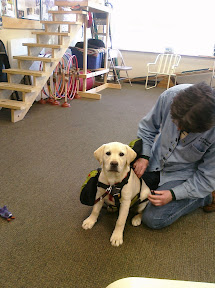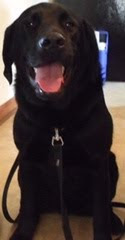Dogs can separate one odor into all its components.
We smell beef stew, they smell potatoes, peas, carrots, etc.
So, what options does a sufferer have to measure his/her odor levels? Apart from purchasing very expensive equipment that would have the capacity to measure only some odorous compounds, which is not practical anyhow, there is also another option - to obtain a Trimethylaminuria Medical Alert Service Dog (SD) trained specifically to give immediate feedback not only about whether a sufferer has odor, but to also indicate if the odor is at a high or low level. The main aim would be to help the person understand their 'smell pattern', Humans acclimate to scent in a room - dogs never doso that perhaps they could alter their diet to suit, to better understand what triggers it, and to plan social activities accordingly.
The service dog could offer many other social skills and psychological benefits, such as being a companion and boosting confidence, for example. An SD’s immediate feedback on a sufferer's odor levels can help him or her feel empowered and confident, allowing for a sense of greater freedom that encourages the sufferer to become more involved in social situations while having lower odor levels. SDs are trained to also sooth anxiety panic-attacks and depression.
MeBO has proactively been looking into testing the possibility of training a service dog for trimethylaminuria sufferers, and ultimately for sufferers of other types of body odor conditions. Initially, the focus will be working with a diagnosed TMAU sufferer, since the odor can be more easily reproduced in a controlled manner to train the dog.
Dogs have a huge amount of brainpower devoted to scent (size of large walnut, matched to a humans pea size area).After looking for dog trainers who specialize in dogs trained to help with health disorders such as diabetes and seizures based on scent, we were fortunate to get a positive and supportive response from Frankfort, Kentucky's Master Trainer Liz Norris, who runs Pawsibilities Unleashed, Pet Therapy of Kentucky, Inc., This non-profit 501(c)3 organization has worked with training SDs for persons with a wide range of disabilities, including Diabetes (works on three different odor levels), Epilepsy, Anxiety/Depression, PTSD, Autism/ASD, Hearing/Signal, Medical Alert conditions (sleep apnea, migraine & Fibromyalgia, Blood pressure, Willims syndrome, Dravet Syndrome, Motility Assistance).
MeBO has been discussing at length the possibility of training a TMAU Service Dog with Pawsibilities' Founder, Liz Norris, AKC-CGC Instructor, and Therapy Evaluator.
Normally it would cost a minimum of $5,000 to train a dog, but Liz has most generously offered us her services and donated to our cause $5,000-worth of training expenses including her personal time and a puppy with the proper temperament to be trained specifically as a TMAU Service Dog. This training will encompass the following:
- Service Dog Manners
- Public Access Work
- Obedience Training
- Scent work
- Crate/House training
- AKC S.T.A.R. Puppy Certification
- AKC Canine Good Citizenship ( if dog is ready)
The plan is to find a volunteer who will be willing to be the first 'owner' of a TMAU Dog, and there is an opportunity for someone to be trained by Liz as a SD Trainer if they wish, in the hope that someday there will be a specialized TMAU, and other Body Odor Conditions, Service Dog Trainer in the USA if the trial is a success.
The only initial expense MeBO will incur for our first TMAU Service Dog will be $130.00 to do vetting for the dog through their program (includes spay or neuter, Microchipping, parvo, distemper, bordetella, worming, frontline for a month and rabies...normally a cost of $300.00+).
Dogs have been used to detect gas leaks 20 feet below ground. The best human instruments could not.
If the TMAU Service Dog project is a success, we hope it would lead to an invaluable program for TMAU and other BO conditions sufferers in the US and abroad. If all goes well, perhaps service dogs can someday assist in the diagnosis of the various body odor/halitosis conditions of persons who test negative for TMAU by helping identify the composition of their odor. As Liz states below, "dogs can separate one odor into all its components. We smell beef stew, they smell potatoes, peas, carrots, etc."
If the TMAU Service Dog project is a success, we hope it would lead to an invaluable program for TMAU and other BO conditions sufferers in the US and abroad. If all goes well, perhaps service dogs can someday assist in the diagnosis of the various body odor/halitosis conditions of persons who test negative for TMAU by helping identify the composition of their odor. As Liz states below, "dogs can separate one odor into all its components. We smell beef stew, they smell potatoes, peas, carrots, etc."

MeBO Research


















